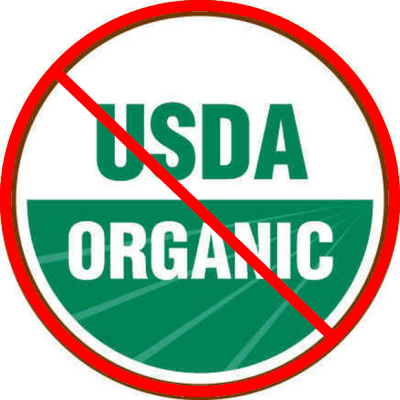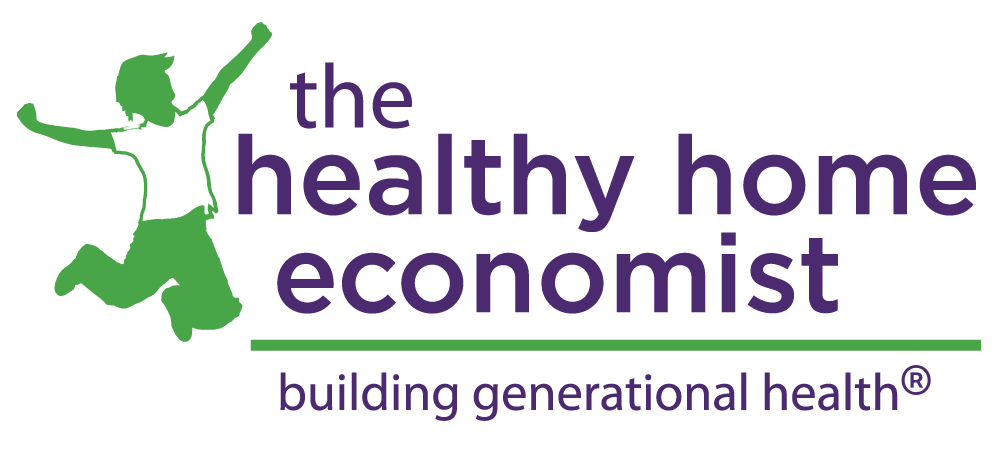 Why would the average consumer decide to switch to organic food? Typical reasons include food of higher quality that is hopefully more nutritious although conventional produce grown locally and picked at the peak of ripeness would no doubt rival the nutrition of organic produce picked early and shipped long distances. Consumers also generally assume that any food labeled as USDA Organic will not contain any dangerous ingredients or chemicals like carrageenan.
Why would the average consumer decide to switch to organic food? Typical reasons include food of higher quality that is hopefully more nutritious although conventional produce grown locally and picked at the peak of ripeness would no doubt rival the nutrition of organic produce picked early and shipped long distances. Consumers also generally assume that any food labeled as USDA Organic will not contain any dangerous ingredients or chemicals like carrageenan.
After all, buying certified organic food is still the only way to avoid genetically modified ingredients as GMOs are regularly slipped into healthfoods labeled as “natural” and even those containing organic ingredients but less than 70% organic overall.
Based on these assumptions, consumers would likely be surprised and even shocked to learn that a likely human carcinogen that triggers massive gastointestinal inflammation and symptoms in many people continues to be allowed by the National Organics Standards Board (NOSB) for inclusion on the list of ingredients permitted in certified organic food – food bearing the USDA Organic label!
This dangerous ingredient, carrageenan, which most consumers are unaware is lurking in so many of their beloved organic products, seems harmless enough at first glance.
Derived from seaweed, carrageenan is a highly processed food additive that has no nutritional function whatsoever.
What it does do is act as a fat replacer or stabilizer in certain types of dairy products, commercial dairy substitutes like soy milk, coconut milk, hemp seed milk, almond milk, and other processed foods.
As you can see, buying lowfat is not a good idea and not just for the fact that you are losing the valuable whole fats that satiate and steady the blood sugar. By opting for lowfat or alternative dairy products, consumers are choosing instead to consume a toxic additive that is a likely carcinogen!
Carrageenan a Potential Carcinogen
Even Dr. Andrew Weil has been telling people about carrageenan dangers since 2002.
Carrageenan is so toxic and inflaming to the human digestive system that this food additive is formally classified by the International Agency for Research on Cancer (part of the World Health Organization) as a potential human carcinogen.
Scientists first discovered that carrageenan causes gut inflammation as far back as the 1960’s. Inflammation is a very serious condition as it is a primary symptom in IBS, Crohn’s Disease, ulcerative colitis, and colon cancer as well as dozens of other diseases.
The hype from the carrageenan industry claims that “food grade” carrageenan is different from the low molecular weight, i.e., degraded carrageenan that is toxic to human cells.
This spin fails to mention that not a single sample of products containing carrageenan that were tested could be said to be free of the degraded form. Some samples contained as much as 25% low molecular weight carrageenan. This testing was conducted as part of a 2003 ruling by the European Commission’s Scientific Committee on Food which required that a maximum of 5% degraded carrageenan be contained in a processed food which includes the additive.
Another problem is that research available since the early 1980’s indicated that even food grade carrageenan is probably converted during the digestive process to the degraded, highly toxic form. More recent research sponsored by the National Institutes of Health (NIH), pinpointed the exact metabolic process by which carrageenan triggers inflammation. Shockingly, this biological event was found to mirror the way pathogenic bacteria such as salmonella wreak havoc in the gut.
The takeaway for consumers from this very discouraging NOSB ruling is to not take anything for granted just because a product is labeled USDA Organic. It still could be extremely damaging to your health!
Avoiding lowfat dairy and processed dairy substitutes is a very wise course of action. If you have a dairy allergy, learn to easily make healthy milk substitutes at home that are free of carrageenan dangers!
Be aware that most commercial pet food is loaded with carrageenan too. Check the labels to be sure your furry friends don’t suffer from its unhealthy effects as well.
Sarah, The Healthy Home Economist
Sources and More Information
The Cultivator, News from the Cornucopia Institute, Summer 2012








Also, soft-serve ice cream.
I was diagnosed last fall with allergy to carrageenan after ten yrs of digestive issues. I don’t think this is a cure-all for me but avoiding it has gone a long way in preventing daily facial and lip/gum swelling along with some digestive problems. A few months ago, I was shocked that I swelled after eating a crossiant purchased at a chain food store and sure enough, the next morning I read the ingredients – there it was. Also, certain brands of toothpaste contain it. I am trying to research if a “product” has low or no-fat milk as an ingredient, do the ingredients of the “product” have to mention if carrageenan was used in creating the low or no-fat milk used in product. For example if I buy Lact-aid milk and it’s 2% not whole milk. Anyone know?
Thanks for this subject. I stopped all dairy for a couple of years due to severe stomach cramps. Then I tried raw milk successfully. Then discovered carrageenan in cream or any dairy or ice cream would cause cramps again. It is not worth using. If I can’t get raw, Strouds brand doesn’t have it, and some Traider Joes is without it.
wow i never knew that! can’t wait to move so i canget a cow and goats! can’t drink milk otherwise and cost to much to make almond milk myself.
The stuff is even in “heavy” cream and half & half for crying out loud. Why would products normally high in fat need a fat enhancement?
My son has many life threatening food allergies, and eats a lot of subsitute yogurt, milk, and cheese products. I am depressed now.
Sheryl,
Don’t be discouraged. My neice also has many life-threatening food allergies, namely dairy, peanuts, and tree nuts. A few things I’ve made at home for her are coconut milk yogurt, coconut milk, oat milk, rice milk, and dehydrated fruits in place of store-bought ready made snacks. She doesn’t like cheese substitutes so meals are very plain but she has found substitutes for almost anything (her favorite being Sunbutter). It takes very little time to process most of these homemade foods, the yogurt takes a little longer, the milks you soak overnight and blend in the morning after they liquefy. You don’t need a substitute food for everything you yourself eat, make it easier on yourself. Cut down to basics and it isn’t a hard transition.
Much luck 🙂
Thank you, Brandy. My son wants to be able to drink milk and eat yogurt and cheese. I found The Healthy Home Economist recipe for Coconut Milk, so I should be able to make that myself. I also need a recipe for non-dairy yogurt, and non-dairy cheese. He is allergic to peanuts, tree nuts, soy, dairy, eggs, and cannot have gluten. I rarely have the patience to cook, but I guess I will have to learn, considering all the unhealthy additives in prepared food.
Carrageenan is not only in plant milks, dairy substitutes, and processed foods it is also in beauty products, pet foods, and toothpaste. Read the labels, its use is widespread. The use of carrageenan should be right up there with GMO….gone!
I never trusted the USDA. Not everything with an organic label is good for you.
I am so glad you posted this article. I too have stayed away from it and was so upset a year ago to see that my almond yogurt contains it. You can easily make your own.
Thanks also to the posters about Applegate. That stinks.
Hi Sarah! Thank you, again, for such an informative and eye-opening article! Would you consider writing a post or two or three about how you do it all! I feel so overwhelmed, with two littles under the age of 4 1/2 and one on the way, everyday! I try to cook three meals a day from scratch, but between the laundry, washing and putting away dishes, and other obligations as a parent, I find it very intimidating every time I learn of a new thing that I need to avoid! I have access to raw milk, but sometimes I am so busy and between my kids naps, its impossible even to make the time to pick it up! Clearly…I need help with organization and a general idea of how in the world you do it all! 🙂
Understand your problem, we all do most likely. Just do the best you can. Meals don’t really need to be cooked 3 times a day, they can be simple. Plan your regular meals, then take some away and change them to a simplified version. Aiden’s carrots weren’t even cooked for dinner last night. He had baby carrots right out of a bag. We must not get too into perfect, the main concern is nutrition, and whether the child will eat it. Plus, when you do have time, make freezer foods, muffins, waffles, cooked meats, beans, burritos, chicken nuggets, etc. Or cook twice as much, eat half, freeze the other half for a busy day. If you do have to buy things, make sure it’s organic/whole foods. Things that come in a box, that’s what you should cook. Mac & cheese is easy. I can do it all in one pan.
Yes, it does get overwhelming at times with our newfound knowledge. Just incorporate new things slowly, unless as in my case, it’s imperative to do immediately.